Nearly three years ago, when the Atlantic Yards plan was announced at a 12/10/03 press conference, the project was, more than anything else, about basketball. The web site for the project was Bball.net. The slogan became “Jobs, Housing and Hoops.”
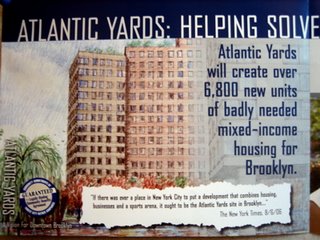 Now, if you listen to Forest City Ratner, the project is mostly about affordable housing—an issue cited but not prioritized at the outset. And, according to the Empire State Development Corporation, it’s about the elimination of blight, an affliction unmentioned at the start.
Now, if you listen to Forest City Ratner, the project is mostly about affordable housing—an issue cited but not prioritized at the outset. And, according to the Empire State Development Corporation, it’s about the elimination of blight, an affliction unmentioned at the start.
Along the way, the jobs issue receded, likely because the number of office jobs plummeted. The developer backed off pledges to make the roof of the arena public park space, to make sure the tallest building didn’t block the Williamsburgh Savings Bank, and to respect the scale of the surrounding neighborhoods.
Perhaps most importantly, the amount of known public subsidy—downplayed from the start—has ballooned, even as major components, such as the support for affordable housing, remain unknown.
Hoop dreams
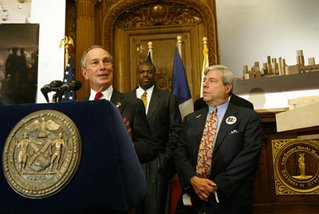 A video of that original press conference, held at Brooklyn's Borough Hall, is available via the Mayor’s web site (go to the December 10 Economic Development Announcement).
A video of that original press conference, held at Brooklyn's Borough Hall, is available via the Mayor’s web site (go to the December 10 Economic Development Announcement).
Fort Greene native Bernard King (behind Bloomberg and Markowitz), a former Net and Knick, was recruited for the event, declaring that “this represents the dreams and aspirations of youth everywhere throughout Brooklyn.” (He was later dropped from the Nets’ team after charges of domestic abuse, and his brother Albert, a lesser star with a clean record, has taken his place.)
Rap star Jay-Z, who described himself as “just a kid from the Marcy Projects and I love Brooklyn.” Citing “prestige, community opportunities, I’m in love with the whole thing,” he concluded, “Let’s get the Nets.” He later was to own a piece of the team.
(Photo credits from press conference: Edward Reed)
Dodgers redux
Brooklyn Borough President Marty Markowitz, who harangued developer Bruce Ratner to buy the Nets--at least according to the official creation story, though Ratner had long eyed the MTA’s Vanderbilt Yard--nearly choked up as he introduced Ratner.
“Bruce, I don’t know what to say to you, I just don’t know what to say," uttered the increasingly verklempt Markowitz. "I just--you don’t know what this little boy, at 12 years old, crying like a baby, I lived on Empire Boulevard and Brooklyn Avenue, a few blocks from Ebbets Field, like a baby—and those tears of joy are swelling up in me, I just can’t wait.”
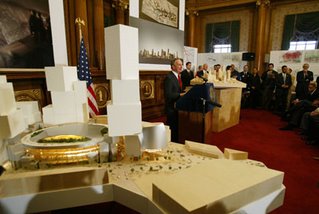 The focus was on the arena and the team. Markowitz, wearing a big button advertising the project, declared, “We are on the threshold of restoring Brooklyn to its rightful place on the national sports stage. Brooklyn, as everyone knows, is a world-class city, and it deserves a world class team playing in a world class arena designed by a world-class architect.”
The focus was on the arena and the team. Markowitz, wearing a big button advertising the project, declared, “We are on the threshold of restoring Brooklyn to its rightful place on the national sports stage. Brooklyn, as everyone knows, is a world-class city, and it deserves a world class team playing in a world class arena designed by a world-class architect.”
Markowitz did offer a look at the bigger picture: “This plan goes even further, creating thousands of apartments affordable to Brooklynites of every income, and producing hundreds of good solid jobs. I’m confident this will be a win-win for the communities surrounding the arena, for all of Brooklyn, and of course all of the city of New York.”
Ratner’s record
When Mayor Mike Bloomberg took the stage, he laid it on thick. Addressing Ratner, he declared, “The MetroTech Center that you created certainly has been an anchor to Downtown Brooklyn's resurgence. It’s brought major employers into the city: Chase Manhattan, Morgan Stanley, Empire Blue-Cross, Blue Shield.”
Actually, MetroTech has served as back office space for employers in Manhattan that were being lured by Jersey City. "Those were not new jobs," Michael Burke, director of the Brooklyn Downtown Business Council, said in a January/February 2005 article in City Limits. "A lot of those jobs existed when the buildings went up. For the most part, they were relocated jobs."
Of Atlantic Yards, Bloomberg said, “This is just going to keep Brooklyn going in terms of job creation and housing and being the magnet that we need to have companies and people from around the world come here. This project is really in some senses the capstone of the renaissance of Brooklyn.”
Local political process
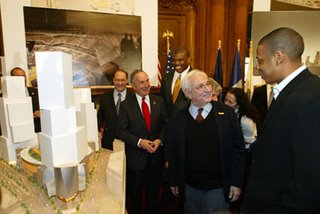 Bloomberg reflected on architect Frank Gehry’s Guggenheim Museum in Bilbao, Spain, adding, “I think it’s just fitting that Brooklyn is on the edge of exciting and innovative and risk taking urban design. One of the things I always thought in Bilbao was: wow, this was a building that was approved by local people--the local political process. You think we have to settle for mediocrity and the conventional. They showed we don’t, and you’re showing that we don’t.”
Bloomberg reflected on architect Frank Gehry’s Guggenheim Museum in Bilbao, Spain, adding, “I think it’s just fitting that Brooklyn is on the edge of exciting and innovative and risk taking urban design. One of the things I always thought in Bilbao was: wow, this was a building that was approved by local people--the local political process. You think we have to settle for mediocrity and the conventional. They showed we don’t, and you’re showing that we don’t.”
(At right, Gehry with Jay-Z.)
What Bloomberg didn’t say was that the “local political process” to approve Gehry’s project in Brooklyn would be bypassed, because the city agreed to have the Empire State Development Corporation fast-track the project, which includes an override of city zoning. The Uniform Land Use Review Procedure (ULURP), which includes City Council and Community Board hearings, does not apply.
Bloomberg declared, “I can just tell you that this administration will put on a full-court press for the approval of this project. We’re prepared to team up with Forest City Ratner and with the elected officials and with the people of Brooklyn to get this going and to bring the Nets to New York.”
“If you’ll pardon a sports analogy, it’s not going to be a slam dunk, but we are all rooting hard and while some of us just have to root from the grandstands, some of us will be on the floor with you,” he added. Bloomberg seemed to be emphasizing the attempt to buy the Nets, which was still in process, but his words apply equally to the city’s efforts to move the entire project along.
Ratner on inclusiveness
Ratner took the podium and showed he’d been schooled well. “Probably the overall guiding principle is inclusiveness, is making sure that listen to everybody and we try to include everybody,” he said.
The includes housing, “and that housing doesn’t mean only market-rate housing, it means middle income and it means affordable housing—and we will get that done,” he said.
Then he cited tickets “affordable for everybody,” “diversity of ownership” (huh?) and enhancing community, whether it be schools or a children’s zone, as some very good local official has said, it’s very important that we have community enhancement, that this project enhances.”
CBA history
Ratner's statement suggests that the Community Benefits Agreement, engineered with the help of Assemblyman Roger Green, was already in process. According to a press release accompanying the 6/27/05 CBA press conference, Green said, "When I proposed a legally binding community benefits agreement, it was not because I doubted Forest City Ratner. Rather, it was because I wanted this community benefits agreement to be part of a process that included community needs at the start of the project…. It's about creating a children's zone where kids can be safe, play and grow.”
Ratner said in that CBA press release, "We turned to these organizations because each has expertise that we believed would benefit the overall project." But groups like Brooklyn Endeavor Experience don't have a track record in their assigned CBA issue.
Creating jobs
“We must create more jobs in this city," Ratner declared at the 12/10/03 event, and then verged toward babble. "It’s what I’ve been about. I made a decision that Brooklyn would be the place where I would develop, because my major goal has been economic development from the time I started as a developer. I understand the importance of having a job. That is critical. So jobs are one of the most important things about this project.”
The number of jobs, of course, has plummeted. Initially, the developer promised 10,000 office jobs. Now the number is 1340, with perhaps 375 of them new rather than relocated from Manhattan. Given the track record of MetroTech, Ratner has mainly "been about" creating office space for jobs to keep them from going to New Jersey, which, from the city's perspective, was a reasonable goal.
Public funding
The Times's coverage added some important context:
"This started with basketball, a Brooklyn sport," Mr. Ratner said. "This was always the site. But it became clear it was not economically viable without a real estate component...
Mr. Ratner said that the project "will be almost exclusively privately financed," although taxes derived from elements of the project will be diverted to help pay for it.
Ratner was even more emphatic on the video: “Another major concept here is: we understand the city’s position and the state’s position and the taxpayer’s position. And it is our goal—in fact we will only use taxes that are generated out of this arena from the public. We do not want to go and get taxes from elsewhere, from the existing base.”
According to an accompanying press release:
The Arena will be primarily privately funded. Incremental revenues will be derived from sales taxes on tickets, food and merchandise sold at the new Arena.
Well, besides sales tax exemptions, mortgage recording tax exemptions, and bond financing, there would be a host of other costs: schools, sanitation, and public safety among them.
The total? Opponents say nearly $2 billion. Some local legislators are still inquiring, and say the project shouldn't be approved until the numbers are known.
Affordable housing
Contrast all that with the urgency of FCR VP Jim Stuckey’s testimony submitted to the ESDC this past August:
I am proud to be here tonight to talk about Atlantic Yards—a project that responds to the basic but dire needs of the borough and the city: for affordable housing, for jobs and economic opportunity. This project will also bring the return of professional sports to our borough, and over seven acres of publicly accessible open space.
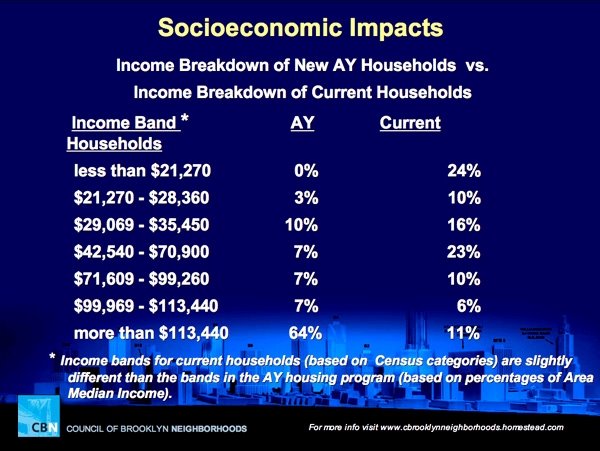 In other words, sports came second. It’s an affordable housing project above all. Except, if you look at the numbers, it’s a luxury housing project above all. Nobody talks about the people who’d be paying market rate for rentals or condos.
In other words, sports came second. It’s an affordable housing project above all. Except, if you look at the numbers, it’s a luxury housing project above all. Nobody talks about the people who’d be paying market rate for rentals or condos.
And we still don't know how much the affordable housing would cost.
Final EIS: blight
According to the executive summary of the Final Environmental Impact Statement, issued last month:
The overarching goal of the proposed project is to transform a blighted area into a vibrant mixed-use community, incorporating principles of environmental sustainability. The proposed project aims to provide a state-of-the-art arena, affordable and market-rate housing, first-class office space, publicly accessible open space, local retail and community services, a hotel (under one variation of the project program), a new subway entrance, and an improved Long Island Rail Road rail yard. The proposed project’s buildings would contribute to the Brooklyn skyline and the open space would connect the surrounding neighborhoods, which are currently separated by the open rail yard and a major avenue (Atlantic Avenue).
Not about blight
 According to the original Project Overview:
According to the original Project Overview:
Brooklyn Atlantic Yards addresses several issues for both Brooklyn and New York City. New York City requires new housing that meets all levels of need and income—and additional office space to create and retain new jobs. The project has four essential components, which support and complement each other: the Arena, commercial space and housing—interspersed with a significant amount of publicly accessible open space to enhance existing neighborhoods.
There wasn't much about the site, and nothing about blight, a crucial term for legal purposes, since it justifies the use of eminent domain:
The primary existing use on the proposed site is a rail storage yard for the Long Island Railroad, which has created a strong psychological and physical barrier between the neighborhoods north and south of Atlantic Avenue.
Goal missed: respecting scale
Some of the goals originally announced haven’t panned out. One was to respect the scale of the existing neighborhoods surrounding the site.
Even Gehry acknowledged that at an appearance last January: "I think the scale issue is the only problem, we're out of whack with that."
Blocking the Willy B
Another goal was that the northernmost building on the site, an office building, will be set back slightly from the intersection of Atlantic and Flatbush Avenues, to maintain the view corridor to the Williamsburg Bank building.
In other words, FCR pledged not to block the bank. Maybe that’s before Frank Gehry finished the designs for his Miss Brooklyn tower and overruled them. But it’s instructive to read the ESDC’s explanation:
Much of Block 1118, located on the southeast corner of Flatbush and Atlantic Avenues, is privately owned and is currently occupied with vacant lots and two low-rise commercial buildings. This block is zoned C6-1 and is within the Special Downtown Brooklyn District, which would permit mid- to high-density residential, commercial, or community facility uses. An as-of-right building up to 495 feet tall could be developed on Block 1118. However, given the location of the Bank Building, even a 320-foot-tall building would substantially obstruct views of the Williamsburgh Savings Bank Building from the south along the Flatbush Avenue view corridor.
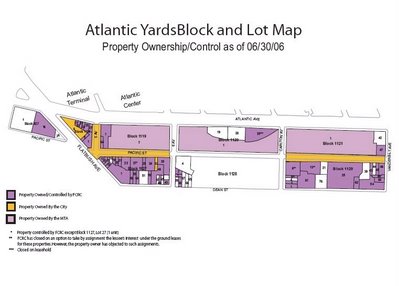 However, there are only two owners of that triangular block at the northwest tip of the project site, east of Flatbush Avenue. As the associated property map shows, one is New York City and the other is Forest City Ratner. In other words, even though FCR could, as of right, build a tall sliver of a building, they could also honor their own promise.
However, there are only two owners of that triangular block at the northwest tip of the project site, east of Flatbush Avenue. As the associated property map shows, one is New York City and the other is Forest City Ratner. In other words, even though FCR could, as of right, build a tall sliver of a building, they could also honor their own promise.
(The ESDC also says that moving the building east wouldn't be feasible from an engineering point of view.)
Arena roof
It’s worth another look at the original pledges regarding the arena roof:
The roof of the Arena offers an exciting opportunity to create new public space, with 52,000 square feet in four lushly landscaped areas for passive recreation and a promenade along the outside edge of the roof with outstanding panoramic vistas facing Manhattan. For active recreation, an outdoor ice-skating rink connects the four gardens; in warmer months the rink will become a running track. This open space not only provides a destination for community residents as well as for the workers in the office buildings—it also allows the commercial buildings surrounding the arena to be connected at the sky-lobby level.
As we know, Forest City has changed plans, and now will offer the arena roof only to residents of the surrounding four towers.
Timing
Originally, the plan was Arena development to begin at the end of 2004, with completion set for the summer of 2006.
The rest of the project was to be in “future phases.” Now everything’s pushed back three years. The developer now projects only two phases. Could there be more?
Why has it taken so long? Markowitz offered a hint. "There will obviously be community concerns such as traffic and parking," he said at the press conference. Later, he added, "The passion is what we call the Brooklyn attitude."
 Now, if you listen to Forest City Ratner, the project is mostly about affordable housing—an issue cited but not prioritized at the outset. And, according to the Empire State Development Corporation, it’s about the elimination of blight, an affliction unmentioned at the start.
Now, if you listen to Forest City Ratner, the project is mostly about affordable housing—an issue cited but not prioritized at the outset. And, according to the Empire State Development Corporation, it’s about the elimination of blight, an affliction unmentioned at the start.Along the way, the jobs issue receded, likely because the number of office jobs plummeted. The developer backed off pledges to make the roof of the arena public park space, to make sure the tallest building didn’t block the Williamsburgh Savings Bank, and to respect the scale of the surrounding neighborhoods.
Perhaps most importantly, the amount of known public subsidy—downplayed from the start—has ballooned, even as major components, such as the support for affordable housing, remain unknown.
Hoop dreams
 A video of that original press conference, held at Brooklyn's Borough Hall, is available via the Mayor’s web site (go to the December 10 Economic Development Announcement).
A video of that original press conference, held at Brooklyn's Borough Hall, is available via the Mayor’s web site (go to the December 10 Economic Development Announcement).Fort Greene native Bernard King (behind Bloomberg and Markowitz), a former Net and Knick, was recruited for the event, declaring that “this represents the dreams and aspirations of youth everywhere throughout Brooklyn.” (He was later dropped from the Nets’ team after charges of domestic abuse, and his brother Albert, a lesser star with a clean record, has taken his place.)
Rap star Jay-Z, who described himself as “just a kid from the Marcy Projects and I love Brooklyn.” Citing “prestige, community opportunities, I’m in love with the whole thing,” he concluded, “Let’s get the Nets.” He later was to own a piece of the team.
(Photo credits from press conference: Edward Reed)
Dodgers redux
Brooklyn Borough President Marty Markowitz, who harangued developer Bruce Ratner to buy the Nets--at least according to the official creation story, though Ratner had long eyed the MTA’s Vanderbilt Yard--nearly choked up as he introduced Ratner.
“Bruce, I don’t know what to say to you, I just don’t know what to say," uttered the increasingly verklempt Markowitz. "I just--you don’t know what this little boy, at 12 years old, crying like a baby, I lived on Empire Boulevard and Brooklyn Avenue, a few blocks from Ebbets Field, like a baby—and those tears of joy are swelling up in me, I just can’t wait.”
 The focus was on the arena and the team. Markowitz, wearing a big button advertising the project, declared, “We are on the threshold of restoring Brooklyn to its rightful place on the national sports stage. Brooklyn, as everyone knows, is a world-class city, and it deserves a world class team playing in a world class arena designed by a world-class architect.”
The focus was on the arena and the team. Markowitz, wearing a big button advertising the project, declared, “We are on the threshold of restoring Brooklyn to its rightful place on the national sports stage. Brooklyn, as everyone knows, is a world-class city, and it deserves a world class team playing in a world class arena designed by a world-class architect.”Markowitz did offer a look at the bigger picture: “This plan goes even further, creating thousands of apartments affordable to Brooklynites of every income, and producing hundreds of good solid jobs. I’m confident this will be a win-win for the communities surrounding the arena, for all of Brooklyn, and of course all of the city of New York.”
Ratner’s record
When Mayor Mike Bloomberg took the stage, he laid it on thick. Addressing Ratner, he declared, “The MetroTech Center that you created certainly has been an anchor to Downtown Brooklyn's resurgence. It’s brought major employers into the city: Chase Manhattan, Morgan Stanley, Empire Blue-Cross, Blue Shield.”
Actually, MetroTech has served as back office space for employers in Manhattan that were being lured by Jersey City. "Those were not new jobs," Michael Burke, director of the Brooklyn Downtown Business Council, said in a January/February 2005 article in City Limits. "A lot of those jobs existed when the buildings went up. For the most part, they were relocated jobs."
Of Atlantic Yards, Bloomberg said, “This is just going to keep Brooklyn going in terms of job creation and housing and being the magnet that we need to have companies and people from around the world come here. This project is really in some senses the capstone of the renaissance of Brooklyn.”
Local political process
 Bloomberg reflected on architect Frank Gehry’s Guggenheim Museum in Bilbao, Spain, adding, “I think it’s just fitting that Brooklyn is on the edge of exciting and innovative and risk taking urban design. One of the things I always thought in Bilbao was: wow, this was a building that was approved by local people--the local political process. You think we have to settle for mediocrity and the conventional. They showed we don’t, and you’re showing that we don’t.”
Bloomberg reflected on architect Frank Gehry’s Guggenheim Museum in Bilbao, Spain, adding, “I think it’s just fitting that Brooklyn is on the edge of exciting and innovative and risk taking urban design. One of the things I always thought in Bilbao was: wow, this was a building that was approved by local people--the local political process. You think we have to settle for mediocrity and the conventional. They showed we don’t, and you’re showing that we don’t.”(At right, Gehry with Jay-Z.)
What Bloomberg didn’t say was that the “local political process” to approve Gehry’s project in Brooklyn would be bypassed, because the city agreed to have the Empire State Development Corporation fast-track the project, which includes an override of city zoning. The Uniform Land Use Review Procedure (ULURP), which includes City Council and Community Board hearings, does not apply.
Bloomberg declared, “I can just tell you that this administration will put on a full-court press for the approval of this project. We’re prepared to team up with Forest City Ratner and with the elected officials and with the people of Brooklyn to get this going and to bring the Nets to New York.”
“If you’ll pardon a sports analogy, it’s not going to be a slam dunk, but we are all rooting hard and while some of us just have to root from the grandstands, some of us will be on the floor with you,” he added. Bloomberg seemed to be emphasizing the attempt to buy the Nets, which was still in process, but his words apply equally to the city’s efforts to move the entire project along.
Ratner on inclusiveness
Ratner took the podium and showed he’d been schooled well. “Probably the overall guiding principle is inclusiveness, is making sure that listen to everybody and we try to include everybody,” he said.
The includes housing, “and that housing doesn’t mean only market-rate housing, it means middle income and it means affordable housing—and we will get that done,” he said.
Then he cited tickets “affordable for everybody,” “diversity of ownership” (huh?) and enhancing community, whether it be schools or a children’s zone, as some very good local official has said, it’s very important that we have community enhancement, that this project enhances.”
CBA history
Ratner's statement suggests that the Community Benefits Agreement, engineered with the help of Assemblyman Roger Green, was already in process. According to a press release accompanying the 6/27/05 CBA press conference, Green said, "When I proposed a legally binding community benefits agreement, it was not because I doubted Forest City Ratner. Rather, it was because I wanted this community benefits agreement to be part of a process that included community needs at the start of the project…. It's about creating a children's zone where kids can be safe, play and grow.”
Ratner said in that CBA press release, "We turned to these organizations because each has expertise that we believed would benefit the overall project." But groups like Brooklyn Endeavor Experience don't have a track record in their assigned CBA issue.
Creating jobs
“We must create more jobs in this city," Ratner declared at the 12/10/03 event, and then verged toward babble. "It’s what I’ve been about. I made a decision that Brooklyn would be the place where I would develop, because my major goal has been economic development from the time I started as a developer. I understand the importance of having a job. That is critical. So jobs are one of the most important things about this project.”
The number of jobs, of course, has plummeted. Initially, the developer promised 10,000 office jobs. Now the number is 1340, with perhaps 375 of them new rather than relocated from Manhattan. Given the track record of MetroTech, Ratner has mainly "been about" creating office space for jobs to keep them from going to New Jersey, which, from the city's perspective, was a reasonable goal.
Public funding
The Times's coverage added some important context:
"This started with basketball, a Brooklyn sport," Mr. Ratner said. "This was always the site. But it became clear it was not economically viable without a real estate component...
Mr. Ratner said that the project "will be almost exclusively privately financed," although taxes derived from elements of the project will be diverted to help pay for it.
Ratner was even more emphatic on the video: “Another major concept here is: we understand the city’s position and the state’s position and the taxpayer’s position. And it is our goal—in fact we will only use taxes that are generated out of this arena from the public. We do not want to go and get taxes from elsewhere, from the existing base.”
According to an accompanying press release:
The Arena will be primarily privately funded. Incremental revenues will be derived from sales taxes on tickets, food and merchandise sold at the new Arena.
Well, besides sales tax exemptions, mortgage recording tax exemptions, and bond financing, there would be a host of other costs: schools, sanitation, and public safety among them.
The total? Opponents say nearly $2 billion. Some local legislators are still inquiring, and say the project shouldn't be approved until the numbers are known.
Affordable housing
Contrast all that with the urgency of FCR VP Jim Stuckey’s testimony submitted to the ESDC this past August:
I am proud to be here tonight to talk about Atlantic Yards—a project that responds to the basic but dire needs of the borough and the city: for affordable housing, for jobs and economic opportunity. This project will also bring the return of professional sports to our borough, and over seven acres of publicly accessible open space.
 In other words, sports came second. It’s an affordable housing project above all. Except, if you look at the numbers, it’s a luxury housing project above all. Nobody talks about the people who’d be paying market rate for rentals or condos.
In other words, sports came second. It’s an affordable housing project above all. Except, if you look at the numbers, it’s a luxury housing project above all. Nobody talks about the people who’d be paying market rate for rentals or condos.And we still don't know how much the affordable housing would cost.
Final EIS: blight
According to the executive summary of the Final Environmental Impact Statement, issued last month:
The overarching goal of the proposed project is to transform a blighted area into a vibrant mixed-use community, incorporating principles of environmental sustainability. The proposed project aims to provide a state-of-the-art arena, affordable and market-rate housing, first-class office space, publicly accessible open space, local retail and community services, a hotel (under one variation of the project program), a new subway entrance, and an improved Long Island Rail Road rail yard. The proposed project’s buildings would contribute to the Brooklyn skyline and the open space would connect the surrounding neighborhoods, which are currently separated by the open rail yard and a major avenue (Atlantic Avenue).
Not about blight
 According to the original Project Overview:
According to the original Project Overview:Brooklyn Atlantic Yards addresses several issues for both Brooklyn and New York City. New York City requires new housing that meets all levels of need and income—and additional office space to create and retain new jobs. The project has four essential components, which support and complement each other: the Arena, commercial space and housing—interspersed with a significant amount of publicly accessible open space to enhance existing neighborhoods.
There wasn't much about the site, and nothing about blight, a crucial term for legal purposes, since it justifies the use of eminent domain:
The primary existing use on the proposed site is a rail storage yard for the Long Island Railroad, which has created a strong psychological and physical barrier between the neighborhoods north and south of Atlantic Avenue.
Goal missed: respecting scale
Some of the goals originally announced haven’t panned out. One was to respect the scale of the existing neighborhoods surrounding the site.
Even Gehry acknowledged that at an appearance last January: "I think the scale issue is the only problem, we're out of whack with that."
Blocking the Willy B
Another goal was that the northernmost building on the site, an office building, will be set back slightly from the intersection of Atlantic and Flatbush Avenues, to maintain the view corridor to the Williamsburg Bank building.
In other words, FCR pledged not to block the bank. Maybe that’s before Frank Gehry finished the designs for his Miss Brooklyn tower and overruled them. But it’s instructive to read the ESDC’s explanation:
Much of Block 1118, located on the southeast corner of Flatbush and Atlantic Avenues, is privately owned and is currently occupied with vacant lots and two low-rise commercial buildings. This block is zoned C6-1 and is within the Special Downtown Brooklyn District, which would permit mid- to high-density residential, commercial, or community facility uses. An as-of-right building up to 495 feet tall could be developed on Block 1118. However, given the location of the Bank Building, even a 320-foot-tall building would substantially obstruct views of the Williamsburgh Savings Bank Building from the south along the Flatbush Avenue view corridor.
 However, there are only two owners of that triangular block at the northwest tip of the project site, east of Flatbush Avenue. As the associated property map shows, one is New York City and the other is Forest City Ratner. In other words, even though FCR could, as of right, build a tall sliver of a building, they could also honor their own promise.
However, there are only two owners of that triangular block at the northwest tip of the project site, east of Flatbush Avenue. As the associated property map shows, one is New York City and the other is Forest City Ratner. In other words, even though FCR could, as of right, build a tall sliver of a building, they could also honor their own promise.(The ESDC also says that moving the building east wouldn't be feasible from an engineering point of view.)
Arena roof
It’s worth another look at the original pledges regarding the arena roof:
The roof of the Arena offers an exciting opportunity to create new public space, with 52,000 square feet in four lushly landscaped areas for passive recreation and a promenade along the outside edge of the roof with outstanding panoramic vistas facing Manhattan. For active recreation, an outdoor ice-skating rink connects the four gardens; in warmer months the rink will become a running track. This open space not only provides a destination for community residents as well as for the workers in the office buildings—it also allows the commercial buildings surrounding the arena to be connected at the sky-lobby level.
As we know, Forest City has changed plans, and now will offer the arena roof only to residents of the surrounding four towers.
Timing
Originally, the plan was Arena development to begin at the end of 2004, with completion set for the summer of 2006.
The rest of the project was to be in “future phases.” Now everything’s pushed back three years. The developer now projects only two phases. Could there be more?
Why has it taken so long? Markowitz offered a hint. "There will obviously be community concerns such as traffic and parking," he said at the press conference. Later, he added, "The passion is what we call the Brooklyn attitude."
Comments
Post a Comment